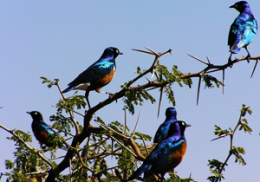Biologist Shows Female Birds of a Feather Compete Together

(PhysOrg.com) -- With its flamboyantly decorated plumage, the peacock is a classic example of how males among many bird species are more visually eye-catching than their female partners. But new research, led by Columbia biologist Dustin Rubenstein, shows that, in some cases, females living in family groups are just as showy as males. The findings, which appear in the Dec. 10 issue of the journal Nature, shed new light on Darwin’s theory of sexual selection.
Darwin noted that sexual dimorphism (differences in male and female traits) generally leads to elaborate-looking males and dull females because reproduction is shared more equally among females than males. As a result, males need fancy duds to compete with other males for the attention of female mates.
In some species, however, females compete as intensively as males for reproductive opportunities. This takes place among species that live in family groups, known as cooperative breeders, in which not all individuals have the chance to reproduce. Scientists believe that in many cooperatively breeding species, not only does reproduction vary inequitably among males, but also among females. Because of this unequal reproduction among both sexes, females must also compete for reproductive opportunities.
“If competition for reproductive opportunities is intense in both sexes in species that live in family groups, it stands to reason that the traits that are typically only elaborate in males might also be elaborate in females in cooperatively breeding species,” said Rubenstein, an assistant professor in Columbia’s department of ecology, evolution and environmental biology.
To test this hypothesis, Rubenstein and Irby Lovette, from the Cornell Laboratory of Ornithology, looked at all 45 species of African starlings and found that cooperatively breeding starlings had reduced sexual dimorphism in both plumage and body size compared with non-cooperative species. That is, males and females in cooperatively breeding species both had ornamented plumage and wing sizes that were similar to those in non-cooperatively breeding species.
Their finding suggests that living in families has important evolutionary consequences, particularly for females. When females have to compete intensively for reproductive opportunities, resources or higher social status in the group, they can be expected to develop exaggerated traits such as increased body size or ornamented feathers, much like the males in most other species.
“This goes beyond starlings,” said Rubenstein. “Any species that lives with relatives might be expected to show similar patterns. This type of complex social behavior is not only common in birds, but also in many mammals—including humans—and insects.”
Provided by The Earth Institute at Columbia University



















